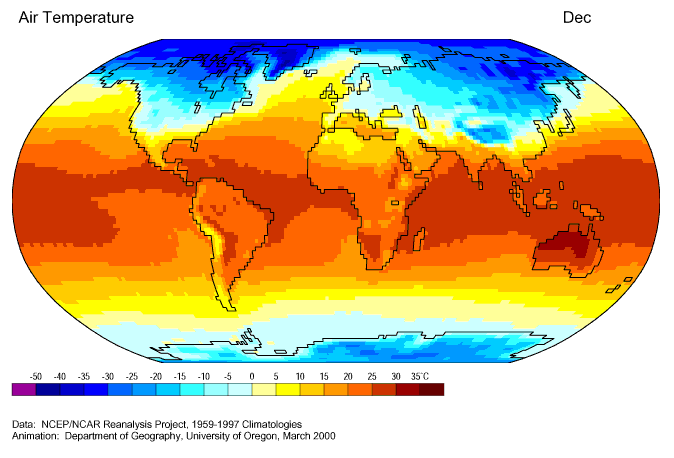
Solar Radiation
Tilt plays an important role on climate of the Earth. Earth’s tilt remains constant at 23.44° during its revolution about the Sun, as explained by the conservation of angular momentum. Hence, the relative orientation of the Earth about the Sun differs over the year. More specifically, from early April to late September, the north hemisphere experiences longer day and that reverses in the other half of the year. These give rise to the equinoxes (same length of day and night) and solstices (longer day or night), as well as the seasons.
Due to the tilt of the Earth, different parts of the Earth receives different amounts of solar radiation at different times of the year.

During the equinoxes, the Sun’s ray shines perpendicularly to the equator, causing both hemispheres to have the same surface area that is exposed to sunlight and thus the lengths of day and night are equal in both hemispheres. During the summer solstice, the northern hemisphere is oriented towards the Sun and the Sun’s ray shines perpendicularly to the tropic of cancer. The Northern hemisphere therefore has larger surface area exposed to sun rays than the Southern hemisphere, causes longer days in the North and longer nights in the South. The reverse occurs during the winter solstice.


Seasons

Seasons are largely characterized by the differences in temperature at certain latitudes across a year. The four seasons are only experienced by a certain range of latitudes on Earth: between 23.5S and 66.5S, as well as between 23.5N to 66.5N. These regions are considered as temperate regions. Latitudes higher than these will experience extreme variation in solar insolation, with the poles experiencing half a year of daylight, one day of equinox, followed by half a year of darkness. On the other hand, the tropics region between 23.5N and 23.5S experiences a less extreme variation in solar insolation throughout the year. This includes Singapore!
The differences in solar insolation will naturally lead to differences in temperature at different latitudes of the Earth.

Since the tropic regions, on average, receive the highest amount of solar radiation in a year, the temperature at these regions remain constantly high throughout the year. However, in temperate regions, the radiation received from the Sun varies with time. This results in the fluctuation in temperature with time and this affects the season experienced. There are some simplified mathematical theories as explained below.
Between 21st March to 22nd September (the equinoxes), the sun ray shines strongly at the Northern hemisphere, resulting in smaller incident angles in the North than in the South. This results in the greater amount of radiation absorbed by the surface of the Northern hemisphere as compared to the regions with the same latitude in the South. Thus, the temperate regions in the Northern hemisphere will experience Spring, whereas temperate regions in the Southern hemisphere will experience Autumn instead. This situation reverses during the other half of the year between September to March. During the solstices, the hemisphere tilting away from the Sun experiences Winter while the hemisphere facing the Sun experiences Summer. Hence, the four seasons experienced on Earth.
At the extreme latitudes, the magnitude of the incident angle of the sun ray is consistently big throughout the year therefore little radiation is absorbed; the big incidence angle causes greater extent of reflection in Earth atmosphere as well, resulting in even less radiation received. The intensity of light diminishes after penetrating thicker atmosphere as well. These factors make the Arctic & Antarctic Circle constantly cold.
